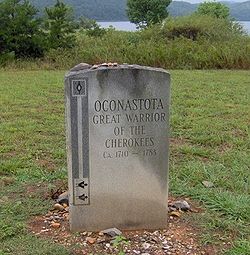
Oconostota
Encyclopedia
Oconostota was the Warrior (skiagusta) of Chota
and the First Beloved Man of the Cherokee from 1775 to 1781.
After the death of his first wife, Oconostota invited Lucy Ward, a former lady-in-waiting to the Queen of England whom he had met in 1730, to join him in Chota
. They were married and had one daughter, Lucy Ward II. The identity of Oconostota's third wife (after Lucy's death in 1758) is unknown.
Oconostota became the Principal Chief of the Cherokee following the death of his cousin Attakullakulla, sometime around 1775-1777. (He was sometimes called "Stalking Turkey", a fact which caused confusion in identifying Oconostota versus his uncle Kanagatucko, "Standing Turkey".) His tenure was fraught with warfare and struggle, which culminated in 1780 in the destruction of Chota-Tanasi by the American revolutionary forces. Oconostota was believed to have died in either 1782 or 1783. He was buried with his hands on his chest holding a broadsword pointing down his body.
 During the archaeological digs at the site of Chota prior to the Tellico Reservoir
During the archaeological digs at the site of Chota prior to the Tellico Reservoir
impoundment, the remains of Oconostota were found. They were identified by a pair of reading glasses which he owned and that were buried with him. Oconostota's remains were re-interred at Chota in the portion raised by TVA
(which includes the site of the council house). A gravestone marks the site.
Chota (Cherokee town)
Chota is a historic Overhill Cherokee site in Monroe County, Tennessee, in the southeastern United States. For much of its history, Chota was the most important of the Overhill towns, serving as the de facto capital of the Cherokee people from the late 1740s until 1788...
and the First Beloved Man of the Cherokee from 1775 to 1781.
Meaning of the name
His Cherokee name, according to Mooney, was Aganstata, which he translated as "groundhog-sausage" (agana = groundhog, and tsistau = "I am pounding it" as in pounding meat in a mortar). It appears as "Oconastota" (with two "a"s) on his grave marker at the site of Chota.Background
Oconostota may have been a son of Moytoy of Tellico, and was born around 1704, one of eleven children. The identity of Oconostota's first wife is a mystery, although she was of the Paint Clan. Their daughter, Nionne Ollie, was the wife of his predecessor, Attakullakulla.After the death of his first wife, Oconostota invited Lucy Ward, a former lady-in-waiting to the Queen of England whom he had met in 1730, to join him in Chota
Chota (Cherokee town)
Chota is a historic Overhill Cherokee site in Monroe County, Tennessee, in the southeastern United States. For much of its history, Chota was the most important of the Overhill towns, serving as the de facto capital of the Cherokee people from the late 1740s until 1788...
. They were married and had one daughter, Lucy Ward II. The identity of Oconostota's third wife (after Lucy's death in 1758) is unknown.
Oconostota became the Principal Chief of the Cherokee following the death of his cousin Attakullakulla, sometime around 1775-1777. (He was sometimes called "Stalking Turkey", a fact which caused confusion in identifying Oconostota versus his uncle Kanagatucko, "Standing Turkey".) His tenure was fraught with warfare and struggle, which culminated in 1780 in the destruction of Chota-Tanasi by the American revolutionary forces. Oconostota was believed to have died in either 1782 or 1783. He was buried with his hands on his chest holding a broadsword pointing down his body.
Memorial

Tellico Reservoir
Tellico Reservoir, also known as Tellico Lake, is a reservoir in Tennessee, created by the Tennessee Valley Authority in 1979 upon the completion of Tellico Dam. The dam impounds the Little Tennessee River and the lower Tellico River...
impoundment, the remains of Oconostota were found. They were identified by a pair of reading glasses which he owned and that were buried with him. Oconostota's remains were re-interred at Chota in the portion raised by TVA
Tennessee Valley Authority
The Tennessee Valley Authority is a federally owned corporation in the United States created by congressional charter in May 1933 to provide navigation, flood control, electricity generation, fertilizer manufacturing, and economic development in the Tennessee Valley, a region particularly affected...
(which includes the site of the council house). A gravestone marks the site.

